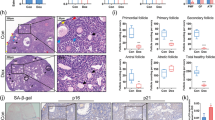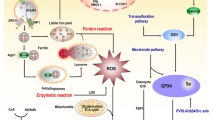Abstract
Chronic arsenite exposure induces immunosuppression, but the precise mechanisms remain elusive. Our previous studies demonstrated that arsenite exposure for 24 h induces G0/G1 arrest in mouse B lymphoma A20 cells and the arrest is caused through induction of cyclin-dependent kinase inhibitor p16INK4a followed by accumulation of an Rb family protein, p130. In this study, we further investigated the consequences of long-term arsenite exposure of A20 cells. The results demonstrated that exposure to 10 μM sodium arsenite up to 14 days induces a great increase in G0/G1 arrest, irreversible cell growth suppression, cellular morphological changes and positive staining for senescence-associated β-galactosidase. The long-term arsenite exposure also induced up-regulation of p16INK4a followed by robust accumulation of p130 and activation of the p53 pathway. Knockdown experiments with siRNA showed that p130 accumulation is essential for cell cycle arrest by long-term arsenite exposure. Since p16INK4a and the p53 pathway are known to be activated by DNA damage, we investigated the involvement of DNA damage formation by long-term arsenite exposure. We found that a variety of DNA repair-related genes were significantly down-regulated from 24 h of arsenite exposure and activation-induced cytidine deaminase was greatly up-regulated after long-term arsenite exposure. Consistent with these findings, long-term arsenite exposure increased a DNA double-strand break marker, γ-H2AX and increased mutation frequency in a Bcl6 gene region. These results revealed that long-term arsenite exposure induces premature senescence through DNA damage increase and p130 accumulation in lymphoid cells.






Similar content being viewed by others
Abbreviations
- Aid:
-
Activation-induced cytidine deaminase
- BER:
-
Base excision repair
- DSBs:
-
DNA double-strand breaks
- HR:
-
Homologous recombination
- Ig:
-
Immunoglobulin
- NER:
-
Nucleotide excision repair
- NHEJ:
-
Non-homologous end joining
- SSBs:
-
Single-strand breaks
- SA-β-gal:
-
Senescence-associated β-galactosidase
References
Ahmed S, Ahsan KB, Kippler M, Mily A, Wagatsuma Y, Hoque AM, Ngom PT, El Arifeen S, Raqib R, Vahter M (2012) In utero arsenic exposure is associated with impaired thymic function in newborns possibly via oxidative stress and apoptosis. Toxicol Sci 129:305–314
Ben-Porath I, Weinberg RA (2005) The signals and pathways activating cellular senescence. Int J Biochem Cell Biol 37:961–976
Bhattacharya P, Grigera F, Rogozin IB, McCarty T, Morse HC 3rd, Kenter AL (2008) Identification of murine B cell lines that undergo somatic hypermutation focused to A: T and G: C residues. Eur J Immunol 38:227–239
Burns LA, Sikorski EE, Saady JJ, Munson AE (1991) Evidence for arsenic as the immunosuppressive component of gallium arsenide. Toxicol Appl Pharmacol 110:157–169
Campisi J, d’Adda di Fagagna F (2007) Cellular senescence: when bad things happen to good cells. Nat Rev Mol Cell Biol 8:729–740
Cascalho M (2004) Advantages and disadvantages of cytidine deamination. J Immunol 172:6513–6518
Chen JH, Hales CN, Ozanne SE (2007) DNA damage, cellular senescence and organismal ageing: causal or correlative? Nucleic Acids Res 35:7417–7428
Cheng H, Qiu L, Zhang H, Cheng M, Li W, Zhao X, Liu K, Lei L, Ma J (2011) Arsenic trioxide promotes senescence and regulates the balance of adipogenic and osteogenic differentiation in human mesenchymal stem cells. Acta Biochim Biophys Sin (Shanghai) 43:204–209
Debacq-Chainiaux F, Erusalimsky JD, Campisi J, Toussaint O (2009) Protocols to detect senescence-associated beta-galactosidase (SA-betagal) activity, a biomarker of senescent cells in culture and in vivo. Nat Protoc 4:1798–1806
Di Noia JM, Neuberger MS (2007) Molecular mechanisms of antibody somatic hypermutation. Annu Rev Biochem 76:1–22
Fiorentino FP, Symonds CE, Macaluso M, Giordano A (2009) Senescence and p130/Rbl2: a new beginning to the end. Cell Res 19:1044–1051
Frasca D, Romero M, Landin AM, Diaz A, Riley RL, Blomberg BB (2010) Protein phosphatase 2A (PP2A) is increased in old murine B cells and mediates p38 MAPK/tristetraprolin dephosphorylation and E47 mRNA instability. Mech Ageing Dev 131:306–314
Funayama R, Ishikawa F (2007) Cellular senescence and chromatin structure. Chromosoma 116:431–440
Geric M, Gajski G, Garaj-Vrhovac V (2014) Gamma-H2AX as a biomarker for DNA double-strand breaks in ecotoxicology. Ecotoxicol Environ Saf 105:13–21
Gharagozloo M, Bagherpour B, Tahanian M, Oreizy F, Amirghofran Z, Sadeghi HM, Hourfar H, Moayedi B (2009) Premature senescence of T lymphocytes from patients with beta-thalassemia major. Immunol Lett 122:84–88
Hayflick L, Moorhead PS (1961) The serial cultivation of human diploid cell strains. Exp Cell Res 25:585–621
Hughes MF, Beck BD, Chen Y, Lewis AS, Thomas DJ (2011) Arsenic exposure and toxicology: a historical perspective. Toxicol Sci 123:305–332
Jackson SP, Bartek J (2009) The DNA-damage response in human biology and disease. Nature 461:1071–1078
Jolly CJ, Klix N, Neuberger MS (1997) Rapid methods for the analysis of immunoglobulin gene hypermutation: application to transgenic and gene targeted mice. Nucleic Acids Res 25:1913–1919
Kuilman T, Michaloglou C, Mooi WJ, Peeper DS (2010) The essence of senescence. Genes Dev 24:2463–2479
Lee BY, Han JA, Im JS, Morrone A, Johung K, Goodwin EC, Kleijer WJ, DiMaio D, Hwang ES (2006) Senescence-associated beta-galactosidase is lysosomal beta-galactosidase. Aging Cell 5:187–195
Li P, Tian C, Ge N, Wang H, Liu L, Lou F, Bjorkholm M, Xu D (2011) Premature senescence of T cells in long-term survivors of renal transplantation. Biochem Biophys Res Commun 407:599–604
Liu M, Schatz DG (2009) Balancing AID and DNA repair during somatic hypermutation. Trends Immunol 30:173–181
Liu M, Duke JL, Richter DJ, Vinuesa CG, Goodnow CC, Kleinstein SH, Schatz DG (2008) Two levels of protection for the B cell genome during somatic hypermutation. Nature 451:841–845
Mandal BK, Suzuki KT (2002) Arsenic round the world: a review. Talanta 58:201–235
Martin-Pardillos A, Sosa C, Sorribas V (2013) Arsenic increases Pi-mediated vascular calcification and induces premature senescence in vascular smooth muscle cells. Toxicol Sci 131:641–653
Muramatsu M, Sankaranand VS, Anant S, Sugai M, Kinoshita K, Davidson NO, Honjo T (1999) Specific expression of activation-induced cytidine deaminase (AID), a novel member of the RNA-editing deaminase family in germinal center B cells. J Biol Chem 274:18470–18476
Nagaoka H, Tran TH, Kobayashi M, Aida M, Honjo T (2010) Preventing AID, a physiological mutator, from deleterious activation: regulation of the genomic instability that is associated with antibody diversity. Int Immunol 22:227–235
Ninomiya Y, Cui X, Yasuda T, Wang B, Yu D, Sekine-Suzuki E, Nenoi M (2014) Arsenite induces premature senescence via p53/p21 pathway as a result of DNA damage in human malignant glioblastoma cells. BMB Rep 47:575–580
Nohara K, Fujimaki H, Tsukumo S, Inouye K, Sone H, Tohyama C (2002) Effects of 2,3,7,8-tetrachlorodibenzo-p-dioxin (TCDD) on T cell-derived cytokine production in ovalbumin (OVA)-immunized C57Bl/6 mice. Toxicology 172:49–58
Nohara K, Ao K, Miyamoto Y, Ito T, Suzuki T, Toyoshiba H, Tohyama C (2006) Comparison of the 2,3,7,8-tetrachlorodibenzo-p-dioxin (TCDD)-induced CYP1A1 gene expression profile in lymphocytes from mice, rats, and humans: most potent induction in humans. Toxicology 225:204–213
Nohara K, Ao K, Miyamoto Y, Suzuki T, Imaizumi S, Tateishi Y, Omura S, Tohyama C, Kobayashi T (2008) Arsenite-induced thymus atrophy is mediated by cell cycle arrest: a characteristic downregulation of E2F-related genes revealed by a microarray approach. Toxicol Sci 101:226–238
Okamura K, Miki D, Nohara K (2013) Inorganic arsenic exposure induces E2F-dependent G0/G1 arrest via an increase in retinoblastoma family protein p130 in B-cell lymphoma A20 cells. Genes Cells 18:839–849
Peled JU, Kuang FL, Iglesias-Ussel MD, Roa S, Kalis SL, Goodman MF, Scharff MD (2008) The biochemistry of somatic hypermutation. Annu Rev Immunol 26:481–511
Rossman TG (2003) Mechanism of arsenic carcinogenesis: an integrated approach. Mutat Res 533:37–65
Ruiz JF, Gomez-Gonzalez B, Aguilera A (2011) AID induces double-strand breaks at immunoglobulin switch regions and c-MYC causing chromosomal translocations in yeast THO mutants. PLoS Genet 7:e1002009
Schulz H, Nagymajtenyi L, Institoris L, Papp A, Siroki O (2002) A study on behavioral, neurotoxicological, and immunotoxicological effects of subchronic arsenic treatment in rats. J Toxicol Environ Health A 65:1181–1193
Shay JW, Wright WE (2000) Hayflick, his limit, and cellular ageing. Nat Rev Mol Cell Biol 1:72–76
Sikora E, Arendt T, Bennett M, Narita M (2011) Impact of cellular senescence signature on ageing research. Ageing Res Rev 10:146–152
Smith AH, Marshall G, Yuan Y, Liaw J, Ferreccio C, Steinmaus C (2011) Evidence from Chile that arsenic in drinking water may increase mortality from pulmonary tuberculosis. Am J Epidemiol 173:414–420
Soto-Pena GA, Luna AL, Acosta-Saavedra L, Conde P, Lopez-Carrillo L, Cebrian ME, Bastida M, Calderon-Aranda ES, Vega L (2006) Assessment of lymphocyte subpopulations and cytokine secretion in children exposed to arsenic. FASEB J 20:779–781
Takumi S, Aoki Y, Sano T, Suzuki T, Nohmi T, Nohara K (2014) In vivo mutagenicity of arsenite in the livers of gpt delta transgenic mice. Mutat Res, Genet Toxicol Environ Mutagen 760:42–47
Unnikrishnan A, Raffoul JJ, Patel HV, Prychitko TM, Anyangwe N, Meira LB, Friedberg EC, Cabelof DC, Heydari AR (2009) Oxidative stress alters base excision repair pathway and increases apoptotic response in apurinic/apyrimidinic endonuclease 1/redox factor-1 haploinsufficient mice. Free Radic Biol Med 46:1488–1499
Valerie K, Povirk LF (2003) Regulation and mechanisms of mammalian double-strand break repair. Oncogene 22:5792–5812
Wang AL, Lukas TJ, Yuan M, Neufeld AH (2008) Increased mitochondrial DNA damage and down-regulation of DNA repair enzymes in aged rodent retinal pigment epithelium and choroid. Mol Vis 14:644–651
Ying S, Myers K, Bottomley S, Helleday T, Bryant HE (2009) BRCA2-dependent homologous recombination is required for repair of Arsenite-induced replication lesions in mammalian cells. Nucleic Acids Res 37:5105–5113
Yu K, Huang FT, Lieber MR (2004) DNA substrate length and surrounding sequence affect the activation-induced deaminase activity at cytidine. J Biol Chem 279:6496–6500
Acknowledgments
This work was supported by the National Institute for Environmental Studies (0710AG333, KN) and Ministry of Education, Science, Sports and Culture, Grant-in-Aid for Scientific Research (19590611, 23390166, KN). We wish to thank Profs Yoshito Kumagai, YasuhiroShinkai (University of Tsukuba), Drs Eiko Koike, Takehiro Suzuki and Shota Takumi (NIES) for their valuable advice; Ms H Murai and H Käch for their great technical assistance; and Ms S.Umehara for her kind secretarial assistance.
Conflict of interest
The authors declare that they have no conflict of interest.
Author information
Authors and Affiliations
Corresponding author
Electronic supplementary material
Below is the link to the electronic supplementary material.
204_2015_1500_MOESM1_ESM.pptx
Summary of mutations in the control cells and cells cultured with 10 μM sodium arsenite for 14 days. a) The amplified sequences of Bcl6 for mutation analysis. The underlined bases are sequenced. b, c) Mutations detected at the 5′ end (b) and 3′ end (c) of the Bcl6 region shown in a) are shown. Mutations in the control cells and in the cells cultured with arsenite for 14 days are shown above and below the sequence
Rights and permissions
About this article
Cite this article
Okamura, K., Nohara, K. Long-term arsenite exposure induces premature senescence in B cell lymphoma A20 cells. Arch Toxicol 90, 793–803 (2016). https://doi.org/10.1007/s00204-015-1500-2
Received:
Accepted:
Published:
Issue Date:
DOI: https://doi.org/10.1007/s00204-015-1500-2




